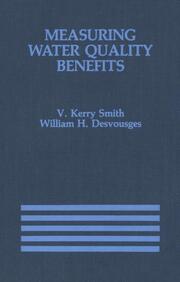Detailansicht
Measuring Water Quality Benefits
International Series in Economic Modelling 3
ISBN/EAN: 9789401083744
Umbreit-Nr.: 5648782
Sprache:
Englisch
Umfang: xvi, 328 S.
Format in cm:
Einband:
kartoniertes Buch
Erschienen am 03.11.2011
Auflage: 1/1986
- Zusatztext
- Almost 5 years ago we began working together on research for the U.S. Environmental Protec tion Agency (EPA) to measure the benefits of water quality regulations. EPA had awarded a contract to Research Triangle Inst~ute (RTIl in response to a proposal that Bill wrote on measuring these benefits. After meeting with the EPA project officer, Dr Ann Fisher, the basic outlines of what would become this research were framed. Upon the suggestion of Bob Anderson, then chief of the Benefits Branch at EPA, we selected the Monongahela River as the focal point of a case study that would compare alternative benefit measurement approaches. Exactly how this case study would be done remained vague, but Ann urged that there be a survey and that nonuse benefits be included in the question naire design. Of course, Bill agreed. At the same time, Kerry was independently working on a review article that tied together some of the loose threads in the option value literature. He had also been thinking about how to measure option value, as well as working on ways to generalize the travel cost approach for estimating benefits of site attributes. Glenn Morris at RTI suggested that Bill have lunch with him and Kerry and that they could talk about Bill's research to see if there were any mutual interest. Over the lunch and Bill's ever present dessert in a Chapel Hill restaurant, we found out just how much we have in common.
- Schlagzeile
- Inhaltsangabe1 Measuring Water Quality Benefits: An Introduction.- 1.1 Background.- 1.2 Regulation: An Overview.- 1.3 Objectives.- 1.4 Preview.- 1.5 References.- 2 The Conceptual Basis of Benefits Estimation.- 2.1 Introduction.- 2.2 A Brief Review of the Conventional Theory of Benefits Measurement.- 2.3 The Treatment of Nonuse Values and Uncertainty in Benefit Analysis.- 2.4 Measuring the Benefits Associated with Changes in Environmental Amenities: An Overview.- 2.5 Benefit Measurement Approaches Considered in This Study.- 2.5.1 The Travel Cost Approach.- 2.5.2 The Contingent Valuation Approach.- 2.5.3 The Contingent Ranking Approach.- 2.6 Summary.- 2.7 References.- Appendix: Analytical Background for Valuation Under Uncertainty.- 3 Survey Design.- 3.1 Introduction.- 3.2 The Monongahela River Basin.- 3.2.1 Geography.- 3.2.2 Uses.- 3.2.3 Recreation.- 3.2.4 Basin Socioeconomic Profile.- 3.3 Sampling Plan.- 3.3.1 Target Population.- 3.3.2 Sample Selection and Survey Design.- 3.4 Survey Plan.- 3.4.1 Questionnaire Design and Limited Local Pretest.- 3.4.2 Retaining Field Supervisors and Hiring Interviewers.- 3.4.3 Counting and Listing of Sample Segments.- 3.4.4 Developing Field Manuals and Conducting Interviewer Training.- 3.4.5 Conducting Household Interviews.- 3.4.6 Initial Contacts and Obtaining Cooperation.- 3.4.7 Household Enumeration.- 3.4.8 Interviewing Procedures.- 3.4.9 Implications.- 3.5 References.- Appendix: Interviewer Debriefing.- 4 Contingent Valuation Design and Results: Option Price and Use Values.- 4.1 Introduction.- 4.2 Design Issues and Contingent Valuation.- 4.2.1 Eliminating Information and Hypothetical Biases.- 4.2.2 Considering the Role of Framing Biases.- 4.2.3 Addressing Procedural Issues.- 4.3 Questionnaire Design.- 4.3.1 Part A-Background.- 4.3.2 Part B-Benefits Measures.- 4.4 Profiles of Survey Respondents.- 4.5 Protest and Outlying Bids.- 4.5.1 Protest Bids.- 4.5.2 Identifying Outliers.- 4.6 Distribution of Option Price Responses.- 4.7 Mean Option Price Responses.- 4.8 Test Findings: Starting Point and Interviewer Biases.- 4.9 Use Value Results.- 4.10 Implications.- 4.11 References.- Appendix: Additional Empirical Results.- 5 Measuring Option Value.- 5.1 Introduction.- 5.2 Recent Estimates of Option Values.- 5.3 Measuring Option Value: Survey Design.- 5.4 Survey Results-Option Value.- 5.4.1 Option Value-Demand Uncertainty.- 5.4.2 Option Value-Supply Uncertainty.- 5.5 Summary.- 5.6 References.- 6 The Contingent Ranking Method and Benefit Estimation.- 6.1 Introduction.- 6.2 The Random Utility Model of Consumer Behavior with Discrete Choices.- 6.3 Estimation of Random Utility Models with Ordered Alternatives.- 6.4 Contingent Ranking and Valuing Public Goods.- 6.5 Applications of Contingent Ranking Method.- 6.6 Monongahela Contingent Ranking Experiment: Design and Estimates.- 6.7 Benefit Estimates with Contingent Ranking Models.- 6.8 Implications and Further Research.- 6.9 References.- 7 The Travel Cost Approach to Recreation Demand Modeling: An Introduction.- 7.1 Introduction.- 7.2 The Household Production Framework and Recreation Demand Models.- 7.3 The Opportunity Costs of Time.- 7.4 Measuring Site Usage.- 7.5 Heterogeneous Recreation Sites and Site Characteristics.- 7.6 Summary.- 7.7 References.- 8 Travel Cost Model: Data Sources and Variable Measures.- 8.1 Introduction.- 8.2 Sources of Data.- 8.2.1 The 1977 Federal Estate Survey.- 8.2.2 Recreation Resources Management System.- 8.2.3 National Water Data Exchange.- 8.2.4 Personal Correspondence.- 8.3 Survey Issues.- 8.3.1 Onsite Survey.- 8.3.2 Multiple Visits.- 8.4 Data Character.- 8.4.1 The Quantity Measure: Visits.- 8.4.2 Distance Cost Component of Travel Costs.- 8.4.3 Time Cost Component of Travel Costs.- 8.5 Site Profile.- 8.6 Congestion at U.S. Army Corps of Engineers Sites.- 8.7 Water Quality.- 8.8 Users.- 8.9 Profile of Activities at the Corps Sites.- 8.10 Summary.- 8.11 References.- 9 Generalized Travel Cost Model.- 9.1 Introduction.- 9.2 Implementing the Gen
